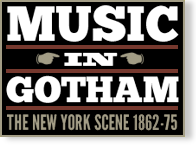Deutscher Liederkranz Testimonial Concert to Agricol Paur
Event Information
Venue(s):
Steinway Hall
Conductor(s):
Agricol Paur
Price: $1; $.50 extra reserved seat
Event Type:
Choral
Record Information
Status:
Published
Last Updated:
23 March 2025
Performance Date(s) and Time(s)
07 Mar 1874, 8:00 PMPerformers and/or Works Performed
Citations
“On Saturday evening the Liederkranz gave a public performance at Steinway Hall of Max Bruch’s new cantata, ‘Scenen aus der Irrfahrt des Odysseus’ (scenes from the wandering of Ulysses), which was produced for the first time in America at one of the entertainments at their club house six weeks ago. We published at that time a pretty full description of it. The repetition, in a larger hall and before the general public, was designed as a complimentary testimonial to Mr. Agricol Paur, the conductor of the society. Whether Paur or Bruch was the chief attraction we are unable to say, but at all events there was a very large audience, and the new work, which is just now exciting a great deal of interest on the continent of Europe, received an attentive and appreciative hearing. We find no reason to modify in any respect the high opinion of its merits which we expressed after the first performance. It is music of a serious and intellectual character, strongly colored with a certain Homeric simplicity and a dignified and natural pathos. It abounds also in fresh and captivating graces, and its impressive flow of melody breaks here and there into passages of remarkable brilliancy and force. The dramatic character of the music is worthy of all admiration. Take, for instance, the first scene, where Ulysses, in the Island of Calypso, receives the visit of Hermes, who breaks the enchantment that bound him to the spot and sends him forth upon his voyage; here the murmuring songs of the nymphs, the noble lament of Ulysses, the stately phrases of the messenger of the gods, and the closing invocation of the hero, ‘Allmächtiger Zeus,’ are superbly contrasted, each retaining its individual character, but all blending in a beautiful whole. Take also the charming scene of Nausicaa and her maidens befriending the shipwrecked chief, or the banquet, with the remarkable chorus of Rhapsodists, and the discovery of the identity of Ulysses; or the final scene, where the wanderer is recognized by Penelope, and the beautiful prayer of thanks, ‘Allmächtiger Zeus,’ recurs as a duet. The formal aria has been discarded by Bruch as completely as it has by Wagner; and though the anomalies which are so conspicuous and so puzzling in the later writings of the author of ‘Tristan’ and ‘Meistersinger’ are not apparent here, the ‘Odyssee’ conforms pretty closely to the new methods, not only in the substitution of ‘continuous melody’ for the conventional metrical structures of the older school, but in the close alliance between the music and the poem, and the important part assigned to the orchestra. The solo parts were given to Mr. Sohst, Miss Anna Simon, Miss Antonia Henne, who all did remarkably well, and Mr. J. Graf, whose part was comparatively unimportant. The chorus was good, but less effective than it was in its own hall, and the orchestra was satisfactory.
The cantata was preceded by a miscellaneous concert, in which the ‘Tannhäuser’ overture was played under the direction of Mr. Bergmann, the Liederkranz gave a male part-song of Möhring’s (‘Vorbei’) with tenor and baritone solos by Mr. Graf and Mr. Steins, and Mr. S. B. Mills contributed Chopin’s Scherzo, opus 20.”
The Liederkranz Society gave a testimonial concert to their conductor, Mr. A. Paur, at Steinway Hall last Saturday evening, assisted by a large orchestra. The concert opened with Wagner’s Tannhäuser overture, followed by a male chorus called ‘Vorher’ by ‘Möhring,’ with solos for tenor and baritone, sung by Messrs. Jacob Graf and Fred. Steins. In this chorus the beautiful phrasing for which this society is renowned was shown to good effect, while, as usual, the soloists were entirely satisfactory. The next item was a Scherzo, opus 20, Chopin, admirably executed by America’s favorite pianist, Mr. S. B. Mills, and for which he received an encore.
Although there was no intermission, these selections really constituted the first part of the programme. The second part consisted of scenes from Max Bruch’s cantata called ‘Odyssee.’ In this fine work the soloists were [see above]. The chorus and orchestra were under the personal direction of Mr. Paur.
The first scene represents Odysseus on the island of Calypso; the second is entitled ‘Odysseus and the Sirens’; the third depicts a tempest at sea; the fourth Nausikaa; the fifth , the banquet; the sixth, Penelope; the seventh, Odysseus’s return; the eighth, the feast in Ithaca.
The work in itself is somewhat after the style of Beethoven’s ‘Mount of Olives.’ The solos and choruses form a series of beautiful classic music such as is not often heard in this city, and the orchestral accompaniments seem like a continuous symphony. The male choruses were especially worthy of notice, for the excellent training they showed. The female choruses were lacking in power, particularly when the orchestra and male voices were in unison. The cantata is preceded by a beautiful overture, which did not receive full justice from the orchestra, as the violins and brass instruments were often out of tune.
The principal soloists was Mr. A. Sohst, who undertook the longest and most difficult rôle in the work, that of Odysseus. His admirable style and magnificent clear voice won for him the entire approbation of the audience. Miss Anna Simon also won hearty applause in her solo and duet with Odysseus; the same can be said of Miss Henne and Mr. Graf, both of whom won instant approbation. Mr. H. Trost sang his small part very creditably. Taken as a whole, the work proved a great success and should be repeated.”

